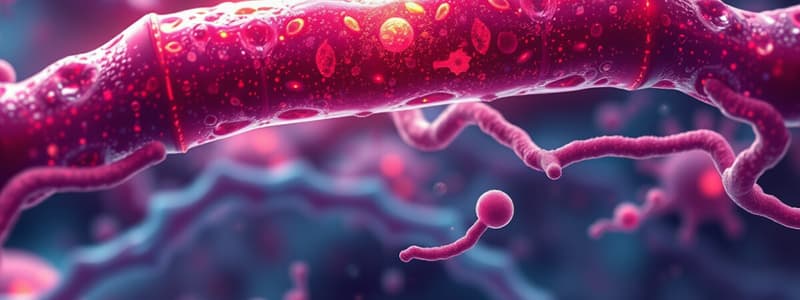Podcast
Questions and Answers
What is the primary function of GLUT2 in relation to blood glucose levels?
What is the primary function of GLUT2 in relation to blood glucose levels?
- It mediates glucose release from adipocytes.
- It increases glucose uptake in muscle cells.
- It decreases glucose transcription in pancreatic cells.
- It regulates blood glucose levels by transporting glucose during high blood glucose conditions. (correct)
Which GLUT transporter is specifically regulated by insulin?
Which GLUT transporter is specifically regulated by insulin?
- GLUT3
- GLUT4 (correct)
- GLUT1
- GLUT2
What characteristic differentiates GLUT3 from GLUT2?
What characteristic differentiates GLUT3 from GLUT2?
- GLUT3 has a high Km, while GLUT2 has a low Km.
- GLUT3 is abundant in muscle while GLUT2 is found in the liver.
- GLUT3 possesses a low Km indicating high affinity for glucose. (correct)
- GLUT3 is regulated by insulin.
Which type of ion channel is primarily influenced by the binding of a specific ligand?
Which type of ion channel is primarily influenced by the binding of a specific ligand?
What event triggers the movement of GLUT4 vesicles to the plasma membrane?
What event triggers the movement of GLUT4 vesicles to the plasma membrane?
What distinguishes the Jmax characteristic of GLUT2?
What distinguishes the Jmax characteristic of GLUT2?
What primary energy source does the Na+/K+ pump utilize for its Action?
What primary energy source does the Na+/K+ pump utilize for its Action?
In which manner does the SGLUT function as a transporter?
In which manner does the SGLUT function as a transporter?
How does digitoxin affect cardiac muscle contraction?
How does digitoxin affect cardiac muscle contraction?
What is the main consequence of increased chloride ion secretion induced by cholera toxin?
What is the main consequence of increased chloride ion secretion induced by cholera toxin?
What characterizes the Na+/Ca2+ cotransporter in muscle cells?
What characterizes the Na+/Ca2+ cotransporter in muscle cells?
Which ion channel is affected by mutations leading to cystic fibrosis?
Which ion channel is affected by mutations leading to cystic fibrosis?
What happens to intracellular Ca2+ levels when the Na+/K+ pump is inhibited?
What happens to intracellular Ca2+ levels when the Na+/K+ pump is inhibited?
What type of transport system is utilized by the Na+/K+ pump?
What type of transport system is utilized by the Na+/K+ pump?
What role does ATP play in the function of CFTR?
What role does ATP play in the function of CFTR?
Which transport type allows Na+ to move with glucose across the intestinal membrane?
Which transport type allows Na+ to move with glucose across the intestinal membrane?
What characteristic is true regarding small uncharged polar molecules crossing the membrane?
What characteristic is true regarding small uncharged polar molecules crossing the membrane?
Which of the following describes the Na+/K+-ATPase membrane pump?
Which of the following describes the Na+/K+-ATPase membrane pump?
Which type of transport relies on specific proteins to allow charged polar molecules to cross the membrane?
Which type of transport relies on specific proteins to allow charged polar molecules to cross the membrane?
What is indicated by a lower Km value for a transporter?
What is indicated by a lower Km value for a transporter?
Which of the following molecules would most likely have the highest permeability across a lipid bilayer?
Which of the following molecules would most likely have the highest permeability across a lipid bilayer?
What is the function of GLUT glucose transporters?
What is the function of GLUT glucose transporters?
How does facilitated diffusion differ from simple passive transport?
How does facilitated diffusion differ from simple passive transport?
What type of molecules generally require specific proteins for membrane transport due to their properties?
What type of molecules generally require specific proteins for membrane transport due to their properties?
Which statement best describes simple passive transport?
Which statement best describes simple passive transport?
Which of the following scenarios best illustrates secondary active transport?
Which of the following scenarios best illustrates secondary active transport?
Flashcards are hidden until you start studying
Study Notes
Membrane Transport Overview
- Membranes function as selective permeability barriers, restricting hydrophilic molecule passage.
- Small uncharged or hydrophobic molecules cross via simple diffusion along concentration gradients.
- Charged polar molecules require specific proteins (pumps, transporters, pores) to traverse membranes.
Mechanisms of Transport
- Types of transport include:
- Simple passive transport/Diffusion
- Facilitated diffusion
- Gated ion channels
- Primary active transport
- Secondary active transport
Passive Transport
- Solutes move down their concentration gradient, achieving equilibrium inside and outside the cell.
- Rate of diffusion linked to the solute's Partition Coefficient; more hydrophobic solutes equilibrate rapidly.
- Example solutes include O2, CO2, H2O, urea, and glucose.
Facilitated Diffusion
- Requires membrane proteins for solute movement across membranes, such as ion channels and specific transporters.
- Examples include Cl-/HCO3- channels in erythrocytes, aquaporin water channels, and GLUT glucose transporters.
Glucose Transporters (GLUT)
- GLUT1: Low Km (~1.8mM), high affinity, found in various tissues for constitutive glucose uptake.
- GLUT2: High Km (~20mM), transports glucose into liver and pancreatic cells when blood glucose is high.
- GLUT3: Located in neurons with low Km, high affinity for glucose.
- GLUT4: Regulated by insulin, present in muscle and adipose tissues; facilitates glucose uptake via membrane recruitment.
Gated Ion Channels
- Allow selective facilitated diffusion for specific ions (K+, Na+, Ca2+).
- Open or close in response to stimuli:
- Ligand-gated (e.g., acetylcholine receptors)
- Voltage-gated (e.g., Na+ and K+ channels in axons)
Active Transport
- Solutes move against concentration gradients, requiring membrane proteins and energy (ATP hydrolysis).
- Example: Na+/K+ ATPase pump maintains Na+ and K+ gradients crucial for nerve transmission.
Na+/K+ Pump
- Tetramer (α2β2) structure of the pump facilitates Na+ entry and K+ export.
- Conformational changes driven by ATP phosphorylation regulate ion binding and release.
Co-Transport Systems
- Utilize pre-established gradients to transport solutes against gradients using ATP-driven primary gradients.
- Includes symport (same direction) and antiport (opposite direction).
Na+-Glucose Cotransporter (SGLUT)
- Facilitates glucose absorption in the intestine against its gradient using the Na+ gradient.
- Functions as a symport, with Na+ driving glucose uptake into cells.
Na+/Ca2+ Cotransporter
- Exports Ca2+ from muscle cells against its concentration gradient using Na+ as an antiport.
Clinical Considerations
- Cardiac Glycosides (Digitoxin/Ouabain): Inhibit Na+/K+ pump, increasing intracellular Na+ concentrations, thereby diminishing Ca2+ export and enhancing heart muscle contractions.
- Cystic Fibrosis (CF): Caused by CFTR mutations, impacting chloride ion transport and leading to thick mucus production, resulting in lung blockages.
- Cholera Treatment: Vibrio cholerae prompts increased secretion of Cl- ions via CFTR, while oral rehydration therapy includes high glucose to enhance Na+ uptake through SGLUT, promoting water absorption.
Summary
- Membrane transport includes various mechanisms such as passive transport, facilitated diffusion, active transport, and co-transport.
- GLUT transporters and the Na+/K+ pump play critical roles in cellular glucose uptake and ion homeostasis, with clinical implications in diseases like cystic fibrosis and heart conditions.
Studying That Suits You
Use AI to generate personalized quizzes and flashcards to suit your learning preferences.




